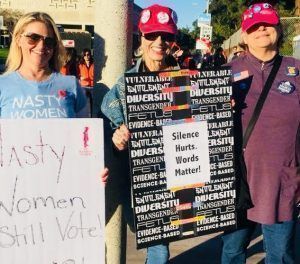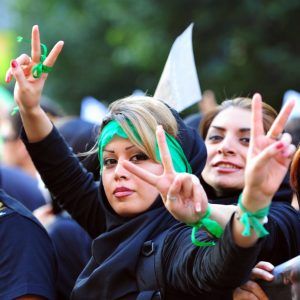[The views expressed in this blog post are the author’s own.]
I am one of the millions of Americans marching in pink Pussyhats holding clever posters. With our Starbucks in one hand and our sign-sticks in the other, we admire each other’s slogans and talk politics. We take selfies and group photos. When the speakers finish their reverie, we march shoulder to shoulder along the marked route protected by uniformed police.

Returning home, I eagerly check my Social Media and flip on the news. Feeling very patriotic, I pride myself in “making a difference”–being a part of #TheResistance.
And then Trump met with Putin.
Now, these marches feel like more like parades than protests. On the heels of the Putin-Trump Summit, we “protesters” may be faced with far greater stakes and at a far greater risk.
I am reminded of Ali Fathollah-Nejad’s PBS Newshour article “Opinion: There’s more to Iran’s protests than you’ve been told.” (April 3, 2018). I remembered this particular piece due to Nejad’s closing paragraph. He quoted, not only an American poet, but one whose voice is linked with the American Civil Rights Movements. Nejad ended his piece with these words:
“This revolt against the 1979 revolution’s broken promises is reminiscent of the precious words in Langston Hughes’ famous poem “Harlem”:
“What happens to a dream deferred? /Does it dry up like a raisin in the sun? /Or fester like a sore— And then run? /Does it stink like rotten meat? /Or crust and sugar over— like a syrupy sweet? /Maybe it just sags like a heavy load.
Or does it explode?”
The next explosion against those dreams deferred might indeed be heavier.”
Rereading the article with different eyes and a frightened heart, I asked myself two questions: Why were the Iranians Protesting? What were they risking? Nejad concluded Iranians protested for three reasons: Social Justice, critique of the Ruling Establishment and the connection between Iran’s regional intervention and its domestic shortcomings.
Once again, the values of the American people and the values of the Iranian people mirror one another. The agenda behind our marches are significantly similar: Human rights (the separating of refugee children from their parents for one), an enormous backlash against the Trump/GOP political agenda and the frustration with Trump’s international relations (tariffs, NATO, EU, The Paris agreement and, of course, Russia).
In the article, it is important to note “Some commentators…have interpreted the protests as merely reflecting Iranians’ desire for a better economic performance.”
Likewise, it may be easy to brush off the “Woman’s march” as more of a social event than a social movement. Perhaps–I wonder about my own commitment. Would I march knowing I might face police wielding batons not to protect me, but to stop me?
I only need to retrace four decades to find photos of fire hoses and vicious dogs being unleashed on peaceful American protesters demanding that their rights not be determined by their race. Without their willingness to risk flesh and blood, America may still have apartheid states. What will I be willing to risk today? America is moving closer to reflect Iran than we are ready to admit. “In fact, the Islamic Republic constitutes an oligarchy, where wealth is monopolized and controlled by the hands of a tiny élite” Nejad writes. Yeah, we get it now.
Among many critical changes in the American political landscape, the “wealth” of our nation has shifted in a steady flow to the Top 1%. Particularly through recent Congressional changes in policies of deregulation, tax reform and international tariff/trade agreements–the financial benefits are a massive windfall for a select elite few families. This is not the American dream. This is not the dream of any nation’s people.
In Nejad’s reflection of the recent Iranian protests, he writes, “The very conditions that led to the uprising – neoliberal economic policies and political authoritarianism – prevailing, the next eruption is only a matter of time. After the state crackdown and the arrest of 4,000 protesters (some of whom died of torture), the protests focused on the prisons.”
The conditions which sparked the Iranian protests have not changed, and despite the “state crackdown”, Nejad predicts the protests will continue.
Given recent allegations of treason by Trump, I have no doubt that also in America “the next eruption is only a matter of time”. We’re getting pretty good at marching now–we know how to apply for permits, the route to walk and the art of sign making.

Is it possible Americans will face government forces ordered not to protect us, but to disperse us? Arrest us? Will we face tear gas? Fire hoses? Bullets? Even as I type these words, I cannot fathom American police officers taking these actions, but I am living in an America I recognize less and less.
The bigger question will be: Will we march by the millions? Will men, women and children take to the streets if we face potential violence? Will we reflect the courage of those we’ve seen in both our history and in streets of countries around the world?
As Ali Fathollah-Nejad concluded his piece with the words of American poet Langston Hughes, I will conclude mine with the message Nejad quotes the Iranian people chanted to their leaders:
“Be afraid, be afraid, for we’re standing together.”



